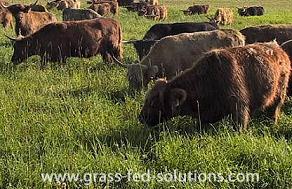Grass Finished Beef:
The seven rules that lead to consistent tenderness and flavor

This article series explores the seven most important considerations that you need to account for in your cattle finishing program to produce consistently tender and flavorful grass finished beef.
In the conventional grain fed beef industry the finishing stage demands a completely separate feeding strategy, typically using a specially formulated feed ration and a confinement feeding system (feedlot) far removed from the grass pastures where the calves were born and raised.
Grass finishing, on the other hand, is merely an extension - a refinement - of the same pasture production strategies used during the cow/calf and stocker stages of the beef production process, which I've discussed in the Cattle, Grazing, Fencing, and Water sections of this website.
However, what sets this finishing stage apart from earlier stages of the beef production process is the meticulous attention that must be paid to all the little details in order to consistently produce tender, flavorful beef.
What are all those little details?
They are summarized below as the Seven Unbreakable Rules for Producing Great Beef:
Seven Rules for Producing Great Beef
These rules are very simple, but very strict. Break any one of them and all your beef finishing efforts will be wasted. Obey them and you will consistently produce tender, nutrient-rich, flavorful grass finished beef.
Use the links within each of the seven rules below to explore each rule in detail and learn how to apply them to your pasture finishing strategy:
The Seven Rules for Producing Great Beef
- Microscopic fat cells within the muscle fibers makes meat tender.
- The 'finished weight' when an animal is fat enough for slaughter will vary from breed to breed and depends on the frame size of the individual animal.
- A meat animal must be gaining weight at the time it is slaughtered.
- Cattle stress makes meat tough and flavorless.
- Nutritional stress is as damaging, or more damaging, than handling stress.
- The side-effects of stress can last weeks or even months after the stress itself is over.
- Cooking techniques are just as important to beef tenderness and flavor as what the farmer does with the cattle on pasture. Switching from cooking grain-fed to grass-fed beef requires a few very simple adjustments.
There are minor differences to how these rules are applied to a grain finishing vs a grass finishing strategy; these differences are discussed within the seven linked articles above. However, ultimately these seven rules apply equally to both grain-finishing cattle in confinement feedlots and to grass-finished beef cattle living on wide open pastures.
Sear these rules into your brain. Read them again and again until you can recite them in your sleep.
Everything you do while finishing cattle for slaughter must accommodate these seven unbreakable rules. They must be built into the very heart of your cattle finishing strategy.
...
Do you have any burning questions about grass finished beef production? Or some more tips on how to grass finish beef cattle?
Share them in the comments box at the bottom of the page or contact me directly through my contact form. And remember to sign up for email notifications or follow me on Facebook or Twitter to get notified of future article releases!



